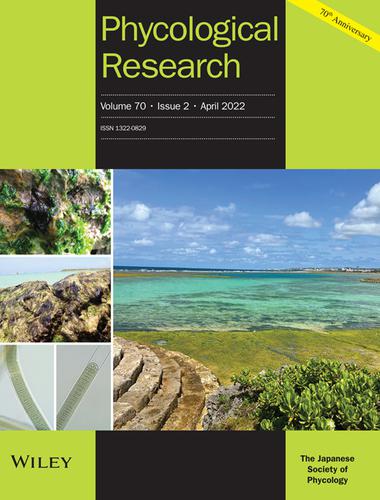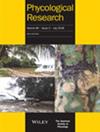问题信息
IF 1
4区 生物学
Q2 MARINE & FRESHWATER BIOLOGY
引用次数: 0
摘要
neolyynbya属(蓝藻)广泛分布在冲绳沿海地区,包括Chatan的Sunabe海滩,这是neolyynbya latusa sp.十一月的类型所在地(右)。在潮间带可以发现附着在岩石或其他硬基质上的宏观菌落。intertidalis sp. 11 .(左上)和N. latusa(左中)的宏观种群图像。光镜下的潮间草丝(左下)和latusa草丝(中下)。不是按比例画的。本文章由计算机程序翻译,如有差异,请以英文原文为准。

Issue Information
Genus Neolyngbya (Cyanobacteria) is widely distributed along coastal region of Okinawa, including in Sunabe beach, Chatan, which is the type locality of Neolyngbya latusa sp. nov. (right). Neolyngbya can be found as macroscopic colony attached to rocks or other hard substrates in intertidal zones. Macroscopic colony images of N. intertidalis sp. nov. (top‐left) and N. latusa (middle‐left). Filament appearances of N. intertidalis (bottom‐left) and N. latusa (bottom‐middle) under a light microscope. Not drawn to scale.
求助全文
通过发布文献求助,成功后即可免费获取论文全文。
去求助
来源期刊

Phycological Research
生物-海洋与淡水生物学
CiteScore
3.60
自引率
13.30%
发文量
33
审稿时长
>12 weeks
期刊介绍:
Phycological Research is published by the Japanese Society of Phycology and complements the Japanese Journal of Phycology. The Journal publishes international, basic or applied, peer-reviewed research dealing with all aspects of phycology including ecology, taxonomy and phylogeny, evolution, genetics, molecular biology, biochemistry, cell biology, morphology, physiology, new techniques to facilitate the international exchange of results. All articles are peer-reviewed by at least two researchers expert in the filed of the submitted paper. Phycological Research has been credited by the International Association for Plant Taxonomy for the purpose of registration of new non-vascular plant names (including fossils).
 求助内容:
求助内容: 应助结果提醒方式:
应助结果提醒方式:


